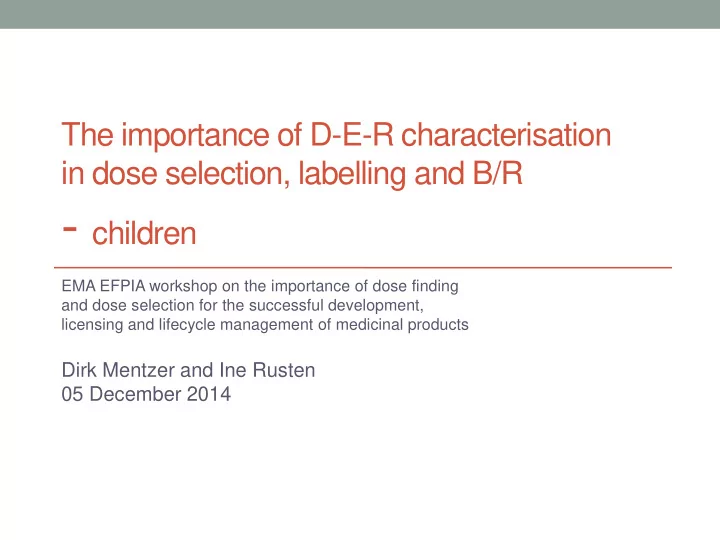

The importance of D-E-R characterisation in dose selection, labelling and B/R - children EMA EFPIA workshop on the importance of dose finding and dose selection for the successful development, licensing and lifecycle management of medicinal products Dirk Mentzer and Ine Rusten 05 December 2014
Disclaimer The opinions expressed during this presentation are those of the speakers, and not necessarily those of the EMA or one of its committees or working parties.
Paediatric developments Dose selection is instrumental in paediatric developments Huge diversity in the paediatric population: understanding appropriate scaling methods is crucial Age range – premature neonates to 17 years • different needs with regard to formulations • differences in opportunities for PK/PD sampling • differences in availability for inclusion in studies • differences in size • differences in status of maturation • differences in relevance of clinical efficacy and safety endpoints
Need for a general strategy Presently huge variability in strategies taken A general outline of a strategy would be useful • to ensure use of all relevant available information • to ensure use of appropriate methodology • to compare PK scaling across similar compounds and PD outcomes in similar disease areas
Proposed general strategy for paediatric dose finding and selection • Collect and systemize drug and system data • In vitro drug data • Non clinical drug data • Adult drug data Collect and • Paediatric drug data systemize • Adult and paediatric drug data on similar (model) substances, indications etc prior information • Adult and paediatric system data (such as relevant physiological, pathophysiological and PK and PD ontogeny data) • Define D-E-R and estimate relevant parameters and variability based on available data Potential methods • PK parameters (F/ka, CL and V) and variability • Population PK/PD/response • PD parameters and variability /safety models • Efficacy and safety parameters and variability Define D-E-R • PBPK/PBPD • Establish covariate relationships in animals, • system pharmacology models • Qualify the models for the existing data at the key interim and final stages adults, children • Bayesian methods • Scale available predictions to the relevant paediatric population Potential methods •Address major assumptions and potential impact of violating assumptions • Allometric scaling •Uncertainty quantification • Organ function such as sensitivity analysis of the important/main parameters (worst/best case scenarios) • Maturation function Predictions •Evaluate if there are assumptions that mandate a conservative approach (titration from lower doses etc) • Co-variate structure for the selected or if there are opportunities for interpolation or partial extrapolation paediatric age subsets Potential methods • Determine type of study(ies) needed • Clinical trial simulations etc. • separate PK study, separate PK/PD study, microdosing study, confirmation of PK/PD within a E&S study in an adaptive manner etc • Determine the need for several doses in order to further inform on the D-E-R relationship also in paediatric patients Study design optimization • Optimization of number of patients and sampling scheme for the PK and PD parameters Learn & confirm paradigm - updating and refining the models with new information
Scaling of D-E to children The standard methods to account for developmental changes in PK • Weight Size • Allometric scaling • Organ function Maturation • Maturation functions • Disease • Co-medication (DDIs) • Nutrition Co- variates • Formulation • Pharmacogenetics • Ethnicity • … All available information should be taken into consideration in an explicit manner.
Scaling of D-E to children The standard methods to account for developmental changes in PK • Weight Size • Allometric scaling • Organ function Maturation • Maturation functions • Disease • Co-medication (DDIs) Standardised parameterisation ? • Nutrition Co- variates • Formulation • Pharmacogenetics • Ethnicity • … All available information should be taken into consideration in an explicit manner. Anderson and Larsson, Paediatr Anaesth. 2011 Mar;21(3):302-8
Prerequisite for extrapolation of PK from adults to children Integrated, quantitative understanding of contribution of pathways to drug ADME Quantitative Mass Balance Diagram Weakest link, but important (DDI risk, paediatric ontogeny, pharmacogenetics, etc) MISG New Technologies Forum on Physiologically-based Pharmacokinetic (PBPK) Modelling and Simulation, June 2013 http://www.mhra.gov.uk/home/groups/comms-ic/documents/websiteresources/con457615.pdf
Scaling of R to children • Often dose selection based only on D-E relationship • goal is similar drug exposure across the whole paediatric population • can lead to failure of clinical paediatric trials if the assumption of no maturation or population effect on the PD of the drug is not valid - in all or in specific paediatric subpopulations. • PD modelling often neglected: little knowledge at present
System data • Knowledge of developmental pharmacology is indispensable to justify the selection of first dose in children. • knowledge of the D-E-R in adults • linked with an early stage plan for the paediatric development would make it possible to describe/collect required system data to support assumptions prior to initiating the paediatric development • in the long run such an approach would influence and potentially decrease the burden of studies required for the paediatric developments… Figure from Barret et al, 2012 Clinical Pharmacology & Therapeutics 92 , 40-49
System data • Knowledge of developmental pharmacology is indispensable to justify the selection of first dose in children. System data are needed to characterize the effects of growth and maturation, such as • ontogeny • physiology • pathophysiology Figure from Barret et al, 2012 Clinical Pharmacology & Therapeutics 92 , 40-49
Learn from experience How to ensure this? • learn and confirm; always updating models • share models and outcomes publish methods, system data and outcome of M&S approaches • qualification procedures for relevant methodologies • • potential for regulatory databases on system data and outcome of different strategies to evaluate how well the predictions turn out in order to learn for next experiments across companies • and therapeutic areas • harmonisation • methodology • regulatory requirements
Questions ? Acknowledgements Ralf Herold, Efthymios Manolis and members of the PDCO and MSWG, in particular Sylvie Benchetrit, Joe Standing and Terry Shepard.
Recommend
More recommend